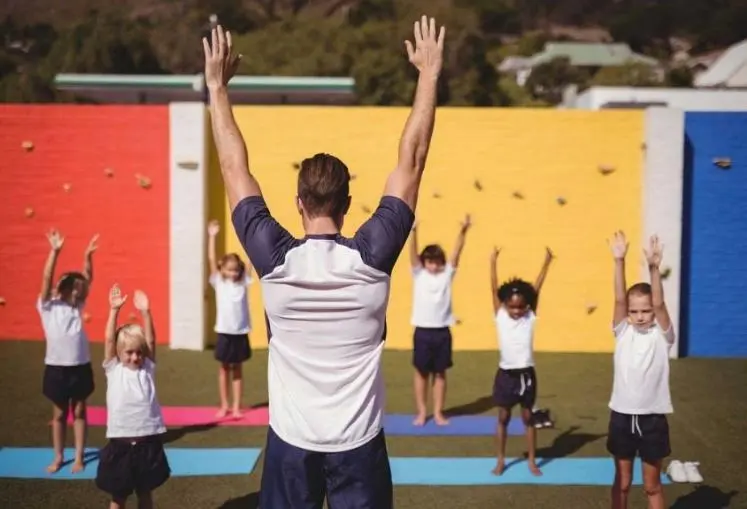In today’s fast-paced world, where sedentary lifestyles and poor dietary habits have become increasingly prevalent, physical health education is more important than ever. It goes beyond simply promoting physical fitness; it teaches individuals how to make informed decisions about their health and well-being. Physical health education plays a crucial role in shaping future generations and fostering a society that prioritizes wellness. It equips young people with the knowledge and skills to make healthy choices, adopt active lifestyles, and ultimately reduce the burden of preventable diseases. This article explores the profound impact of physical health education on society, emphasizing its importance for future generations.
Key Takeaway
Physical health education is a powerful tool that can transform individuals and society. It empowers people to make informed decisions about their health, reduces the prevalence of preventable diseases, and fosters a culture of wellness. By investing in physical health education today, we are ensuring a healthier, more resilient society for future generations.
What is Physical Health Education?
Physical health education is a comprehensive approach to promoting physical well-being, including physical fitness, proper nutrition, mental health awareness, and disease prevention. It typically involves both theoretical and practical components that focus on developing healthy habits, improving physical activity levels, and fostering a positive attitude toward health and wellness. The goal is to prepare individuals to make informed decisions about their physical and mental well-being, starting at a young age and continuing into adulthood.
Key Components of Physical Health Education
- Physical Fitness: Physical health education emphasizes the importance of regular physical activity, including exercises that promote cardiovascular health, strength, flexibility, and endurance.
- Nutrition Education: Students are educated about the role of nutrition in maintaining a healthy lifestyle, learning about balanced diets, proper hydration, and the impact of food on overall health.
- Mental Health Awareness: Physical health education recognizes the interconnection between physical and mental health. It promotes emotional well-being, stress management, and strategies to build mental resilience.
- Disease Prevention: By learning about common health conditions such as obesity, diabetes, heart disease, and other lifestyle-related illnesses, students are encouraged to adopt preventive measures to reduce the risk of these diseases.
- Healthy Habits: Establishing long-term habits like adequate sleep, personal hygiene, and regular physical activity is central to physical health education.
The Impact of Physical Health Education on Society
| Impact Area | Description | Example |
|---|---|---|
| Improved Public Health | Physical health education promotes healthy habits and behaviors, leading to a reduction in preventable diseases. | Decreased rates of obesity, heart disease, and diabetes due to awareness and action. |
| Enhanced Quality of Life | Education about physical health increases life expectancy and overall well-being by encouraging healthy lifestyles. | Individuals adopting regular exercise routines, leading to better physical and mental health. |
| Cost Reduction for Healthcare | Encouraging exercise and healthy living reduces the burden on healthcare systems by preventing chronic diseases. | Fewer hospital visits and reduced healthcare costs due to improved physical health. |
| Increased Productivity | Healthy individuals tend to have higher energy levels, focus, and motivation, leading to improved productivity. | Employees who participate in regular physical activity are often more productive at work. |
| Better Mental Health | Physical health education also includes mental health awareness, leading to reduced stress and anxiety. | Reduced rates of depression and anxiety as more people engage in physical activities. |
| Promotes Social Inclusion | Physical education programs often bring people together, fostering social connections and teamwork. | Community sports leagues and fitness classes that encourage socializing and inclusivity. |
| Empowered Communities | Physical health education empowers individuals with knowledge and skills to make healthier lifestyle choices. | Community workshops on healthy eating, exercise, and mental well-being. |
| Cultural Change Toward Health | Over time, physical health education helps to create a culture where fitness and well-being are prioritized. | A society where regular exercise and healthy eating become the norm, not the exception. |
Promoting Long-Term Health
One of the most significant impacts of physical health education is its role in promoting long-term health. By instilling the importance of regular exercise and healthy eating habits at an early age, physical health education encourages individuals to make healthier lifestyle choices throughout their lives. Studies have shown that those who engage in physical health education from a young age are more likely to continue these habits into adulthood, leading to reduced rates of obesity, heart disease, and other chronic conditions.
Reducing Healthcare Costs
A well-educated population is more likely to prioritize preventive measures, which can lead to a reduction in the overall cost of healthcare. By focusing on healthy lifestyles and disease prevention, physical health education can significantly decrease the prevalence of preventable diseases. This, in turn, reduces the burden on healthcare systems and the economy as a whole. For example, promoting exercise and good nutrition can reduce the risk of chronic diseases like Type 2 diabetes and heart disease, leading to fewer medical treatments, hospitalizations, and long-term care needs.
Building Stronger Communities
Physical health education helps create healthier communities by fostering social connections through group activities, sports, and fitness programs. When individuals participate in physical activities together, they build relationships and strengthen community bonds. Additionally, by encouraging physical health education in schools and community centers, society can create environments where wellness is a shared value. This collective effort not only improves the health of individuals but also enhances the social fabric of the community as a whole.
Empowering Youth and Encouraging Active Lifestyles
Physical health education empowers young people by providing them with the tools they need to take control of their health. Through physical education classes, extracurricular sports, and fitness programs, students develop the skills to be active and healthy throughout their lives. This sense of empowerment can be particularly important for youth in underserved communities, where access to fitness programs and healthy living resources may be limited. By investing in physical health education, we are equipping the next generation with the knowledge and confidence to make positive health decisions, which will benefit both individuals and society in the long run.
Tackling the Growing Obesity Epidemic
Obesity has become a significant public health issue worldwide, with millions of children and adults affected by this preventable condition. Physical health education provides the tools to combat this growing epidemic by educating individuals on the importance of physical activity and balanced nutrition. Schools that incorporate physical health education into their curricula can play a pivotal role in reducing childhood obesity rates and promoting healthier eating habits among students. Additionally, physical health education programs that promote physical fitness and educate about portion control, balanced meals, and mindful eating can help combat the negative effects of an increasingly processed and convenience-based food environment.
Mental Health Benefits
The benefits of physical health education extend beyond the body to the mind. Regular physical activity has been linked to improved mental health outcomes, such as reduced stress, anxiety, and depression. By incorporating mental health education into physical health curricula, students learn how to take care of their emotional well-being as well as their physical health. Teaching coping mechanisms for stress, encouraging positive body image, and fostering self-esteem are all important aspects of physical health education that help students develop into well-rounded, resilient individuals.
The Role of Physical Health Education in Schools

Physical health education (PHE) plays a vital role in shaping the health and well-being of students, and its importance extends beyond simply promoting physical activity. In schools, PHE programs aim to provide students with the knowledge, skills, and attitudes to lead healthy lives and to understand the connection between physical health and overall well-being.
Promotes Physical Fitness and Activity
Physical health education provides students with structured opportunities to engage in physical activities, which are crucial for developing cardiovascular fitness, muscular strength, and coordination. Regular exercise helps children develop healthy habits that can last a lifetime.
- Benefits: Regular physical activity can help reduce the risk of obesity, diabetes, heart disease, and other chronic conditions. It improves bone density and muscle strength, contributing to the growth and development of children.
- Example: School activities like running, swimming, team sports (basketball, soccer), and individual exercises (yoga, dance) promote fitness and overall health.
Supports Mental and Emotional Health
Physical health education is not only beneficial for the body but also plays a significant role in mental health. Engaging in physical activity helps release endorphins, the body’s natural mood boosters, which can help alleviate symptoms of anxiety and depression.
- Benefits: Physical activity improves self-esteem, reduces stress, and enhances overall emotional well-being. It also promotes better sleep patterns and cognitive function, which are essential for academic success.
- Example: Students involved in regular physical activities, like team sports or physical education classes, often experience reduced anxiety and are better equipped to handle emotional stress.
Teaches Healthy Lifestyle Habits
One of the main goals of physical health education in schools is to teach students about healthy lifestyle choices that they can carry into adulthood. This includes education on nutrition, physical activity, hygiene, and the harmful effects of substances like tobacco and alcohol.
- Benefits: By learning about healthy eating, exercise, and avoiding harmful habits early on, students are more likely to adopt and maintain healthy behaviors as they grow older.
- Example: Schools may incorporate lessons on nutrition, such as the importance of balanced diets, the effects of sugar on the body, and the need for hydration.
Promotes Social Interaction and Teamwork
Physical education classes and extracurricular sports provide students with valuable opportunities to interact with their peers in a social setting. This helps them develop communication skills, teamwork, leadership, and conflict resolution abilities.
- Benefits: Building teamwork skills, learning to collaborate with others, and understanding the importance of supporting and respecting teammates can help students develop socially and emotionally. It also contributes to a positive school culture and sense of community.
- Example: Team sports like soccer, volleyball, or basketball encourage cooperation and healthy competition, fostering friendships and teamwork.
Encourages Long-Term Physical Activity
Physical health education in schools helps instill the importance of maintaining an active lifestyle, not just for academic or athletic success but as a lifelong habit. It encourages students to engage in physical activities that they can enjoy well into adulthood.
- Benefits: Students who are introduced to various sports and fitness activities at an early age are more likely to continue being active throughout their lives, which can prevent sedentary lifestyles and reduce the risk of developing chronic diseases.
- Example: Offering a wide variety of activities, such as swimming, dancing, cycling, or hiking, gives students the tools to find an exercise they enjoy and can continue to pursue as they grow older.
Improves Academic Performance
While it may seem unrelated, physical activity is closely linked to improved academic performance. Regular exercise helps improve concentration, memory, and overall cognitive function. It also enhances the brain’s ability to learn and retain information.
- Benefits: Physical activity boosts brain function, leading to improved attention, focus, and better performance in academic tasks. Active students tend to perform better on tests and homework assignments.
- Example: A school that schedules daily physical activity breaks or incorporates physical movement into lessons often sees students engage more effectively in the classroom.
Promotes Discipline and Goal Setting
Engaging in sports or structured physical education classes requires students to follow rules, adhere to routines, and set and achieve goals. These aspects of physical health education help students develop discipline, perseverance, and goal-setting skills.
- Benefits: Discipline learned in sports and physical education settings translates to other areas of life, including academics and personal goals. It encourages students to push through challenges and remain motivated.
- Example: Training for a sports event or a fitness challenge can teach students the importance of goal-setting and sticking to a plan.
Fosters Inclusivity and Reduces Bullying

Physical health education can play a role in fostering inclusivity and reducing bullying. When all students participate in physical activities, regardless of their athletic ability, they develop a sense of belonging and appreciation for each other’s unique strengths and weaknesses.
- Benefits: Inclusive physical education classes help break down social barriers and reduce the likelihood of bullying related to body image, physical appearance, or fitness level.
- Example: Adaptive physical education programs allow students with disabilities to participate alongside their peers, ensuring they have equal access to physical activity and social interaction.
Addresses Childhood Obesity
In recent years, childhood obesity has become a growing concern. Schools play a critical role in addressing this issue through physical health education, promoting regular physical activity, and educating students about proper nutrition.
- Benefits: By fostering healthy habits and providing the knowledge to make informed choices, schools can help prevent childhood obesity and its associated health risks, such as type 2 diabetes, hypertension, and heart disease.
- Example: Schools that offer healthy lunch options and integrate nutrition lessons into their physical education curriculum help students learn how to manage their weight and stay healthy.
Provides Lifelong Skills
Physical health education doesn’t just focus on short-term goals like improving fitness or losing weight. It aims to provide students with the skills, knowledge, and attitudes they need to live long, healthy, and productive lives.
- Benefits: Physical health education programs give students the tools to stay active, manage stress, and make healthy decisions well into adulthood.
- Example: Teaching students how to create their own exercise routines, understanding the importance of stretching and recovery, or guiding them on how to set long-term fitness goals prepares them for a healthier life.
Shaping Healthy Habits Early On
Schools play a crucial role in physical health education because they provide a structured environment in which students can learn and practice healthy behaviors. The earlier children are exposed to concepts such as the importance of exercise, healthy eating, and mental well-being, the more likely they are to carry these habits into adulthood. Physical health education in schools lays the foundation for lifelong wellness by teaching children the benefits of staying active and making healthy choices.
Integrating Physical Health Education with Academic Learning
Integrating physical health education into the academic curriculum allows students to connect the importance of physical health with their overall academic success. Research has shown that students who engage in regular physical activity perform better academically, have improved concentration, and show greater cognitive function. When schools prioritize physical health education, they create a holistic learning environment that supports students’ intellectual, physical, and emotional development.
Also Read : Building Resilience: Strategies For Improving Mental And Physical Wellness
Conclusion
Physical health education is not just about fitness; it’s about equipping future generations with the knowledge and tools they need to lead healthy, active lives. Its impact on society is profound, from promoting long-term health and reducing healthcare costs to fostering strong communities and empowering youth. By teaching children the importance of exercise, balanced nutrition, and mental well-being, physical health education helps shape a future generation that values and prioritizes health. As we continue to face challenges related to obesity, chronic diseases, and mental health, the importance of physical health education has never been clearer.
FAQs
What are the main components of physical health education?
Physical health education includes physical fitness, nutrition education, mental health awareness, disease prevention, and the establishment of healthy habits.
How does physical health education benefit society?
It promotes long-term health, reduces healthcare costs, builds stronger communities, empowers youth, combats obesity, and improves mental health.
Can physical health education help reduce childhood obesity?
Yes, by teaching children about proper nutrition, the importance of physical activity, and healthy lifestyle choices, physical health education can help reduce childhood obesity rates.
How does physical health education impact mental health?
Regular physical activity, which is a key part of physical health education, helps reduce stress, anxiety, and depression, while improving self-esteem and emotional well-being.
Why is it important to teach physical health education in schools?
Teaching physical health education in schools helps children develop healthy habits early on, which they can carry into adulthood, reducing the risk of chronic diseases and promoting overall well-being.
How can physical health education reduce healthcare costs?
By encouraging healthier lifestyle choices, physical health education helps prevent diseases such as heart disease, diabetes, and obesity, ultimately reducing the financial burden on healthcare systems.
What are the long-term benefits of physical health education?
The long-term benefits include improved physical and mental health, reduced healthcare costs, a more active and engaged population, and a society that values wellness.




